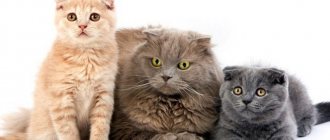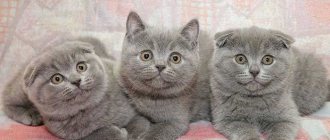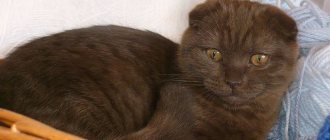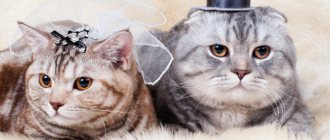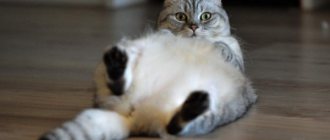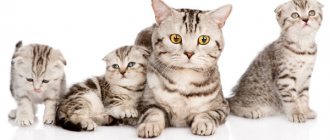Scottish cats have different colors. Scottish cats are famous because of their charming appearance and variety of colors. The color of kittens directly depends on certain genes. As a rule, these are two main shades, black and white.
Scottish Straight colors, for example, are gray with black stripes around the entire body. They are distributed as a percentage. That is, the animal’s fur is painted in two colors in different proportions. Its own gene is responsible for the dominance of one color or another.
Plain (solid)
The color of Scottish Fold cats is monochromatic and they should not have any other color. The fold-eared cat can be of the following colors: white and black, chocolate and lilac, blue and red, cream, fawn and cinnamon. The most popular color in the world among solid Scottish cats is blue. These are the majority of cats.
White
The white Scottish Straight cat can have different eyes, from blue and bright orange to rich amber and copper. Kittens of this variety remain white for the rest of their lives. If kittens have spots, then an adult cat remains white for the rest of its life.
Black
The Scottish Fold black cat is mostly bright in color. A couple of white hairs are acceptable, but if the cat has large red and brown patches, then it is not a purebred.
Black Scottish Fold cats should be bright black in color and their ears, like all fold-eared cats, should be pressed to the head, unlike straight-eared cats. A straight-eared black cat always has its ears erect.
Chocolate
The chocolate Scottish Fold looks impressive. The chocolate color is quite rare. Brown fold kittens should have a smooth, uniform coat of chocolate color. The dark brown coloring adds nobility to the cat.
A brown cat gets this color if he has chocolate, chocolate bicolor or chocolate color points in his pedigree. Chocolate Scottish kittens always delight their owners. They look very cool against a light background.
Lilac (lavender)
A lilac long-eared cat gets this color if he has either lilac color points or lilac in his pedigree. The lilac coloration goes well with orange, copper or amber colored eyes and a light brown nose. This color is also called coffee with milk.
Blue color (blue)
The Scots Blue can have a coat color of many shades of blue. Some cats may have a fur color closer to gray, and some closer to blue. Each hair must be saturated, then the coat will be perfectly blue.
Small pets have different patterns that disappear after a few months. Three months after birth, their eyes may be copper-colored.
Red (red)
Red Scots are a very rare breed. The ginger Scottish cat, like the ginger kitten, has a tail defect in the form of unevenly colored fur. In red-haired pets, red is sometimes more dominant than red.
These cats may have patterns on their foreheads and limbs, but this is not considered the norm. The Scots, unlike the British cat breed, can give birth to either a red fold-eared cat or a straight-eared cat.
Cream
The soft peach coat of a lighter color gives this cat an elegant appearance. At first glance, they are very similar to the red ones, but if you look closely, you can clearly see the difference. Cream hairs are lighter. Smooth patterns on the paws and tail are acceptable, but leopard spots are not acceptable.
Faun (deer)
The coat of kittens of this breed is a very interesting color. This shade should not be confused with lilac, which has a lilac tint. The paw pads and nose of these cats are beige-pink.
Cinnamon
At first this color can be confused with chocolate, but this is not so. This look is lighter and softer. Its nose and pads are beige or pink-brown.
Character and habits
Scottish Folds are cats that were bred exclusively as a breed for home keeping. Its representatives have never lived on the street, so they tend to become very attached to their owner and home. Even rearranging furniture can cause stress for a Scottish Fold, let alone moving to a new place of residence.
Adult Scottish Folds have a phlegmatic character. They display a sedateness and aristocracy, which was probably inherited from British cats. They behave calmly and balanced in any situation. Kittens are usually playful and inquisitive, but they can hardly be called hyperactive.
Sensitive and vulnerable by nature, Scottish Folds need affection more than representatives of other breeds. Begging for the next portion of affection, the pet literally follows on the heels of the object of its adoration. Seizing the moment when the owner is free, the fold-eared cat will immediately try to capture his attention and sit next to him.
Scottish Fold cats do not tolerate separation from their owner well. For them, this is a real test, which can lead to loss of appetite or even illness due to stress.
Despite their strong affection for humans, Scottish Folds do not like to be picked up or cuddled. They prefer to bask in the arms of their owner, lying next to them on the bed or sitting in a chair. Scottish Folds are not very talkative; moreover, they have a quiet voice, reminiscent of a squeak. Some owners of Scottish Folds have never heard their pets meow at all.
Interaction with children
Scottish Fold cats are often bred specifically for children. An affectionate and calm pet can become a child’s best friend, provided that the child respects his personal space. Although Scottish Folds are not happy with annoying hugs, they do not allow themselves to be aggressive towards children. There are practically no cases when a cat is ready to use its claws and teeth; this is rather an exception to the rule. A lop-eared pet will prefer to retire to a safe place for a while rather than offend the baby.
How do Scottish Folds get along with other animals?
Scottish Folds feel comfortable in the company of a dog, especially if the pets grew up together. Friendship with cats of other breeds is also possible, but you need to keep in mind that Scottish Folds are jealous. If there are several cats living at home, then each of them should receive care and attention equally. The one thing Scotswomen cannot get along with is parrots and small rodents. Although cats of this breed seem slow, they have a well-developed hunting instinct.
Upbringing
Scottish Folds are smart, so they easily learn to order. They quickly remember how to use the tray and scratching post, and learn the rules of behavior in the house. The main condition for successful parenting is patience and perseverance. Rough treatment can only lead to the loss of the pet's trust. It is better to use reward methods - praise and treat the cat with something tasty when it shows obedience.
Bicolors
The coat color of these beautiful creatures has two colors, and a combination of white and any other shade is mandatory. Purebred bicolors must have a white belly, neck, chest, chin, limbs and, of course, muzzle.
join the discussion
Share with your friends
Cats are one of the cutest pets, and there are those who just look at you and make you smile, and you have an irresistible urge to look for them. These cats include the Scottish Fold breed, or otherwise the lilac Scottish Fold cat.
Buying Scottish Fold, how to buy correctly?
When buying a kitten you need to pay attention to the following:
- The kitten's ears should fit snugly to the head;
- The head should be round and the coat plush and soft;
- The kitten's gait and movements should be smooth and flexible (fold-eared cats may have diseases of the musculoskeletal system at the genetic level, which can occur when these animals are improperly crossed);
- The tail should be flexible and not very long;
It is recommended to buy kittens from trusted nurseries, where crossing is carried out according to all the rules for breeding this breed.
When buying an animal from unknown people, there is a risk of developing joint diseases in the future, due to possible unscrupulous compliance by these people with the conditions of crossing its ancestors.
There are 3 types of lop ears:
- Single fold ears (if only the ends of the ears are bent);
- Double fold (the ears bend entirely at the base of the auricle, leaving a small gap between the ears and the head);
- Triple fold (complete fit of the ears to the head).
The coat color of cats can be either monochromatic or with a variety of color shades.
Unusual color
Cats of this breed are very cute and beautiful; their lilac color gives them a sophisticated aristocratic look. Even their nose and paw pads are lilac in color - they cannot mix and appear any color other than their own, in this case lilac. A different color is unacceptable not only on the animal’s fur, but also on other parts of the body (tail, ears, paws). You can meet representatives of this breed whose undercoat shade will be a little lighter, but still there will not be much difference from the main color.
Breed characteristics
These are amazing cats; two different temperaments can be combined in one animal. In childhood, these are energetic and playful kittens; in adulthood, they are imposing, quiet and calm cats. Representatives of Scottish Fold cats have a body of medium length, proportional and with soft curves, strong paws, wide pads, a long tail and always straight. The head has a round shape, cats have thick, pronounced cheeks. The ears are triangular and small, the tips are drooping, the eyes are large and round, their color may vary depending on the color of the coat. Mainly due to the head and muzzle, animals of this breed are easily recognizable.
Animals can weigh up to 6 kilograms, with an average height of 30 centimeters. Their average life expectancy is 15 years; if disease prevention is carried out and with a good pedigree, the cat can live up to 20 years.
Like any animal, they have their pros and cons, but each cat is individual. Their bad qualities include: vindictiveness, a tendency to obesity, since they do not have a sense of proportion and satiety in food, and they shed a lot.
Their good qualities are that representatives of this breed are smart and sociable animals. Their distinctive feature is independence and cleanliness, although they do not require special care.
And most importantly, in adulthood they are lazy cats; they do not need active games with their owners.
Author: felinologist Elena Shabaeva
If you ask the average person what color Scottish cats are, he will certainly answer that they are gray (the color among professionals is called blue). This is a common color of Scottish cats. But today the variety of colors is very large. Therefore, when asked what colors of Scottish cats there are, you must boldly answer: any! To get such a wide palette, Scots had to be crossed with other breeds. Today, interbreeding is not encouraged, because cats already have the necessary set of genes.
In this article we will answer the following questions: what color are Scottish kittens, what color are Scottish cats, what are the main genes that form the colors of Scottish Fold and Straight-eared cats (Scottish Straight, Scottish Fold, Highland Straight and Highland Fold).
Also in the article we will talk about how the color of Scottish kittens changes with age, and show photos of Scottish cats and kittens of almost all colors. Absolutely all colors cannot be presented within the framework of the publication, because... there are a lot of them, and the genes, combining in a bizarre way, still surprise breeders.
Education and training
Fold cats are very smart and easy to train. Teaching your pet basic skills is not difficult.
It is advisable to accustom your cat to order and discipline from an early age. To accustom a kitten to the tray, it is enough to often play with it not far from the tray and, if necessary, immediately put it there.
Soon he will remember where to relieve himself.
Teach your fold cat to listen to its owner and understand the command “No!” You can use a regular baby rattle.
It is enough to simply rattle it loudly over his ears and loudly say “No!” when he does something forbidden (for example, tries to climb on the table or starts scratching the furniture).
Folds are very sensitive to loud sounds at an early age, so training using similar methods gives results. It is not recommended to physically punish a kitten, as in the future it may stop trusting its owner and be afraid of him.
For good behavior and obedience, the pet must be praised and rewarded with some kind of treat.
Scottish Folds very quickly get used to the house and the owner. Despite their independence, they still require at least a little attention. If the owner is often not at home, the kitten may begin to meow in the middle of the night, thereby attracting attention to itself.
To prevent this from happening, you need to devote at least 10-20 minutes of time to it before going to bed. They rarely spoil things and almost never jump on furniture and curtains.
If your pet is left alone in the apartment for a long time, it is enough to leave him a few toys, such as balls or a rubber mouse. In this case, the pet will not be bored for a long time, and will have something to do in the absence of the owner.
COLORS OF SCOTTISH CATS and types of color
The colors of Scottish cats are divided into solid, tortoiseshell, smoke, tabby, bicolor, van, harlequin, shaded, chinchilla, point and ticked. This does not depend on the type of breed. Such colors can equally be found in Scottish folds, Scottish straights, highland folds and highland straights.
Solid (solid, monochromatic) colors
Solid color means that there are no inclusions of another color. The tone should be rich and even along the entire length of the hairs. If there are inclusions of a different color, this is either a different color or a defect, which reduces the price of the kitten and lowers the ratings at shows.
Solid colors come in blue (what lay people call grey), black (ebony), white, brown (chocolate), lilac, fawn (meaning “young deer” in English), cinnamon (cinnamon), red and cream.
Until recently, blue was considered a classic: such cats were the majority. However, today this is no longer the case. However, black, white, chocolate and red Scots are rarer creatures.
Two-color (bicolor)
Bicolor is the color of Scottish cats in which half the surface of the coat is white, and the other half is blue, cream, red or tabby. It is desirable that the drawings are symmetrical.
Point colors
The body of color point cats should have a basic light tone, and the face, ears, paws and tail should be darker. Hence the name: translated from English, the word “color” means “color”, and “point” means “point”.
Scottish point cats can be of several varieties: seal point, lilac point (white body with lilac markings), blue point (light body and light blue markings), chokelit point (white body and brown markings), cream point (light cream body and cream markings), tortoiseshell (tortoiseshell, which combines the base color markings with red or cream spots), tabby point (striped markings). There are other options for points.
Rare colors of Scottish cats
Many readers ask what the rarest and most expensive colors of Scottish cats are. Today there are no problems finding any color, however, among breeders trying to get the maximum variety of colors of kittens from one cat, tortoiseshell cats are very much appreciated, because... they carry the genes of both the red and black series at once. Among ordinary people who are not involved in breeding, the so-called precious colors - gold and silver - are now in fashion. However, these colors can no longer be called rare, since such cats are becoming more and more popular due to their popularity.
And for those who are in search of what is the best color of Scottish cats, let’s say: this is the color that you like, because you live with this cat. You may become interested in cats whose color is as close to natural as possible, that is, spotted or tabby. Or maybe you will like red (ginger) cats, because... they please the eye and improve your mood with their appearance. Whatever color you choose, the main thing is that you like it.
Name options for fold-eared cats
Observing its character for several days can help you come up with a nickname for a fold-eared kitten.
It is recommended not to give a name that is too long, since in this case the cat will not always be able to respond to it. If there are children in the house, the pet can be named after a cartoon character.
Examples of nicknames for Scottish cats: Ricci, Albert, Garfield, Harry, Barry, Donald, Henry, Pierrot, Charlie, Wolf, Tom, Silver, Ronnie, Pierre.
Examples of nicknames for cats of the Scottish breed: Dixie, Tilda, Erica, Gressy, Gabi, Betty, Jessie, Lady, Misty, Haze, Molly, Richie.
A bit of genetics
Many people are interested in learning how the colors of Scottish cats are formed. In Scottish cats, two genes predominate, responsible for black and red coat colors. Each of them can act as a dominant (suppressing weaker genes) and recessive (suppressed gene). And there is a third diluent gene, responsible for the saturation of the pigment. Combining in a certain order, these genes can give completely unimaginable coloring. If you are interested in the topic of the genetics of the colors of Scottish cats and what coloring results from crossing, come here. And we will continue.
The presence of one color or another in a Scottish kitten cannot always be determined in the first weeks of life. This is not the final shade yet, because the coloring becomes brighter and more pronounced only when the coat is replaced by an adult during the baby's molt. This happens around six months of age. But up to 2 years, the shade may still change slightly.
